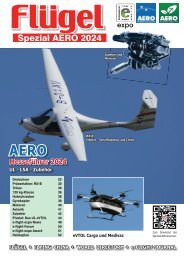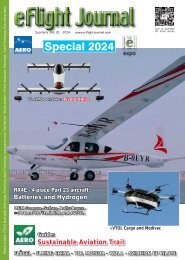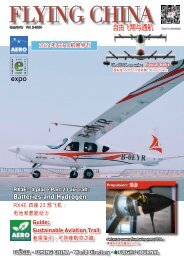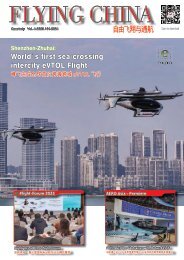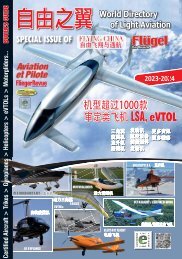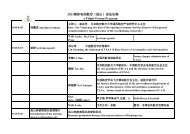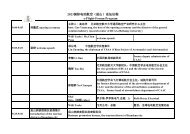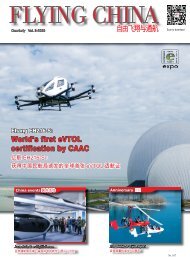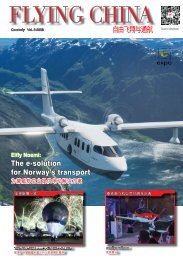eFlightJournal-04-2020+01-2021double issue
E-Flight Journal double issue The Journal for electric aviation, hybrid electrical Aircraft and Evtol from the Publisher Flying Pages
E-Flight Journal double issue
The Journal for electric aviation, hybrid electrical Aircraft and Evtol from the Publisher Flying Pages
You also want an ePaper? Increase the reach of your titles
YUMPU automatically turns print PDFs into web optimized ePapers that Google loves.
e Technology<br />
article in this <strong>issue</strong>), the French also offer a turbo generator,<br />
the TG-R55, which will soon be followed by the more<br />
powerful brother TG-R90, where “TG” means turbo generator<br />
and “R” stands for recuperative, while the number<br />
behind it refers to the generator output in kilowatts. Turbotech<br />
has coupled the regenerative turbine in the TP-<br />
R90 turboprop engine with a reduction gear that drives<br />
the propeller. In the turbo generator, the shaft is coupled<br />
to an electricity generator, the current version of which,<br />
with a weight of 55 kilos, produces the 55 kilowatts documented<br />
in the name. The more powerful variant with a<br />
90 kW generator, which is to go into production after the<br />
successful test of the 55 kW generator, will weigh 64 kilos,<br />
according to the manufacturer.<br />
Increased efficiency<br />
A new type of heat exchanger increases the fuel efficiency,<br />
that results in the efficiency of the turbine and, consequently,<br />
that of the entire turbo generator package. In the<br />
TGR55 turbo generator, the turbine directly drives a generator<br />
flanged to the front. The generator delivers a continuous<br />
electrical output of 53 kW (400 to 900 volts direct<br />
current); other values are also feasible upon customer request.<br />
Incidentally, the TG is started by the generator, as<br />
it can also function as a starter. According to Turbotech,<br />
the TG-R55 package has an electrical efficiency of 26<br />
percent, calculated from the fuel tank to the inverter. This<br />
is slightly lower than the efficiency of the turbo-prop from<br />
the same house, since every energy generation / conversion<br />
involves certain losses. According to the company,<br />
the TG-R55 package weighs 115 kilos as a range extender.<br />
The package includes 50 kilos of Jet A1 fuel, which<br />
corresponds to an electrical output of 155 KWh. According<br />
to Turbotech, this 115 kilo package is equivalent to a<br />
1000 kilo battery pack. Like the Turboprop TP-R90, the<br />
turbo generator is also multi-fuel capable and runs on<br />
Jet-A1, diesel, biofuel and hydrogen.<br />
Turbotech developed the control of the turbine itself,<br />
which gave the company the opportunity to adapt it so<br />
that several TGR90 units can be connected to one another<br />
up to a total output of 500 kilowatts. The turbine has already<br />
been operated and tested at 55 KW (around 90 PS)<br />
at Turbotech and is expected to be launched on the market<br />
as the TG-R55 at the end of 2021. If the turbine has<br />
also proven itself in the TP with 90 kW, the power of the<br />
turbo generator is increased to 90 kW. It should then be<br />
available as TG-R90 in mid / late 2022. The total weight of<br />
this package should be 64 kg dry and 74 kilos installed.<br />
Overall electrical efficiency will likely be 23 percent from<br />
the tank to the inverter exit.<br />
Low outer skin temperature<br />
Due to the regenerative properties of the TG-R55 / R90<br />
and the use of the heat exchanger, the generator package<br />
is very quiet. The exhaust gases escape from the exhaust<br />
pipe at a much lower speed. The thermal signature<br />
of the turbo generator will also be significantly lower than<br />
today’s turbine packages, which are much hotter. This<br />
will be particularly interesting for the UAV (unmanned<br />
aerial vehicles) market. Of particular interest is the fact<br />
that the outer skin of the turbine is only around 200 degrees<br />
Celsius even at full power - and that without additional<br />
insulation. This benefits the composite structures<br />
of modern eVTOLs, since these materials are thermally<br />
quite sensitive. Turbotech is assuming a TBO of 3000<br />
hours (which is expected to grow), which - coupled with<br />
the simplicity of the turbine construction with few moving<br />
parts - means tangible advantages in terms of maintenance<br />
as well. The price of the TG-R55 generator is currently<br />
65,000 euros’ net.<br />
Two end products<br />
Turbotech has approached the story very cleverly and<br />
has developed two end products from a regenerative<br />
turbine, the development of which required considerable<br />
financial resources, the turboprop TP and the turbo<br />
generator TG, which serve completely different market<br />
segments. In my opinion, the emerging market for electrically<br />
powered aircraft, hybrid drives and especially for<br />
the countless eVTOL aircraft and aviators with distributed<br />
electric drives will show interest in the turbo generator.<br />
After all, these applications are power-hungry and have<br />
been waiting in vain for the repeatedly announced, lighter<br />
batteries with higher energy density for years. The high<br />
efficiency of the complete package from Turbotech and<br />
the advantages of high power density, compact dimensions,<br />
low weight and low vibrations with a low acoustic<br />
signature - could this be the solution for eVTOLS? 4<br />
The inner<br />
parts of the<br />
Turbotech<br />
turbine.<br />
1 / 2021<br />
e Flight Journal<br />
55




